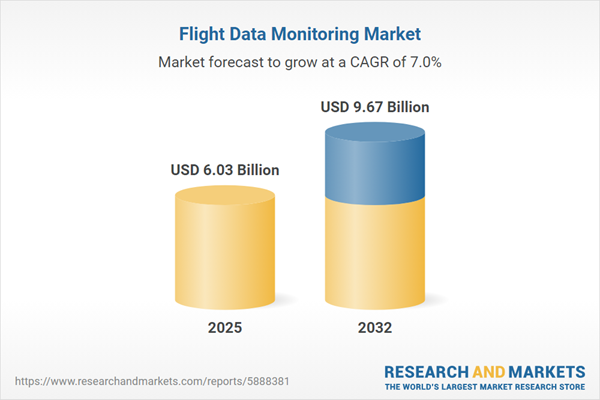Speak directly to the analyst to clarify any post sales queries you may have.
Flight Data Monitoring is a foundational technology for current and next-generation aviation. Senior decision-makers will recognize its decisive influence in streamlining operational safety, meeting evolving compliance demands, and optimizing cost efficiency across diverse aviation environments.
Market Snapshot: Flight Data Monitoring Market Overview
The Flight Data Monitoring Market grew from USD 5.63 billion in 2024 to USD 6.03 billion in 2025. This sector is projected to sustain robust expansion, registering a CAGR of 6.98% and is forecasted to reach USD 9.67 billion by 2032. Increasing adoption across airlines, business jet operators, and military aviation, coupled with technological advancements, underpins this momentum. The demand for advanced analytics, integrated system architectures, and modular solutions is shaping both investment and operational decision-making in this critical market segment.
Scope & Segmentation: Navigating the Flight Data Monitoring Landscape
Comprehensive Segmentation
- Component: Hardware, Software, Managed Services, Professional Services, Support Services
- Application: Flight Operations, Maintenance, Training
- Deployment Model: Cloud (Private Cloud, Public Cloud), On-Premise (Hosted, In-House)
- End-User: Business Jets, Commercial Airlines, General Aviation, Military
Regional Coverage
- Americas: United States, Canada, Mexico, Brazil, Argentina, Chile, Colombia, Peru
- Europe, Middle East & Africa: United Kingdom, Germany, France, Russia, Italy, Spain, Netherlands, Sweden, Poland, Switzerland, United Arab Emirates, Saudi Arabia, Qatar, Turkey, Israel, South Africa, Nigeria, Egypt, Kenya
- Asia-Pacific: China, India, Japan, Australia, South Korea, Indonesia, Thailand, Malaysia, Singapore, Taiwan
Key Technologies
- Technological Solutions: High-precision sensors, real-time telemetry, cloud analytics, artificial intelligence, machine learning, edge computing, digital twins
Company Coverage
- GE Aviation, Inc.
- Honeywell International Inc.
- Collins Aerospace Inc.
- Airbus SE
- The Boeing Company
- Thales S.A.
- L3Harris Technologies, Inc.
- SITA S.A.
- Lufthansa Systems GmbH & Co. KG
- Flight Data Services ApS
Key Takeaways: Strategic Insights for Senior Decision-Makers
- Integrated Flight Data Monitoring solutions are essential in supporting preemptive risk management, providing the tools for continuous monitoring and proactive intervention.
- Advanced analytics platforms and AI-driven tools transform flight data into actionable insights, streamlining maintenance and refining standard operating procedures.
- Customization and adaptability remain vital—military, business, and commercial operators require solutions tailored to unique performance and regulatory needs.
- Diverse deployment models, including cloud and on-premise options, are selected based on security, data sovereignty, and operational flexibility.
- Service robustness, from managed services to immersive training, ensures long-term compliance and stakeholder readiness across operator categories.
- Geographical dynamics influence adoption rates and deployment strategies, requiring alignment with regional regulatory, infrastructure, and language requirements.
Tariff Impact: Adjusting to Regulatory and Trade Shifts
Recent tariff measures in the United States have imposed higher import duties on avionics and telemetry components, compelling manufacturers and service providers to reconsider sourcing and assembly strategies. These adjustments have increased costs and extended supply-chain timelines, promoting nearshoring and domestic partnerships. Operators and procurement specialists are reevaluating logistics, contracting, and customs processes to mitigate the impact of these regulatory shifts while safeguarding deployment schedules and total cost of ownership.
Methodology & Data Sources
This study integrates primary research—including structured interviews with senior aviation professionals—with comprehensive reviews of secondary sources such as technical standards, regulatory filings, and industry white papers. Data validation involved triangulating expert panel feedback, quantitative analysis, and thematic reviews to deliver well-founded, actionable intelligence for stakeholders.
Why This Report Matters
- Enables informed investment by equipping decision-makers with targeted analysis across all significant segments of flight data monitoring.
- Highlights regional and regulatory drivers to refine go-to-market and implementation strategies.
- Supports competitive positioning by detailing innovations, supplier strategies, and partnership opportunities relevant to aviation leadership teams.
Conclusion
This report equips aviation stakeholders with a structured framework for leveraging Flight Data Monitoring as a driver of operational resilience, safety, and compliance. Executives can apply these insights to navigate shifting technology and policy landscapes with confidence.
Additional Product Information:
- Purchase of this report includes 1 year online access with quarterly updates.
- This report can be updated on request. Please contact our Customer Experience team using the Ask a Question widget on our website.
Table of Contents
3. Executive Summary
4. Market Overview
7. Cumulative Impact of Artificial Intelligence 2025
Companies Mentioned
The companies profiled in this Flight Data Monitoring market report include:- GE Aviation, Inc.
- Honeywell International Inc.
- Collins Aerospace Inc.
- Airbus SE
- The Boeing Company
- Thales S.A.
- L3Harris Technologies, Inc.
- SITA S.A.
- Lufthansa Systems GmbH & Co. KG
- Flight Data Services ApS
Table Information
| Report Attribute | Details |
|---|---|
| No. of Pages | 199 |
| Published | October 2025 |
| Forecast Period | 2025 - 2032 |
| Estimated Market Value ( USD | $ 6.03 Billion |
| Forecasted Market Value ( USD | $ 9.67 Billion |
| Compound Annual Growth Rate | 6.9% |
| Regions Covered | Global |
| No. of Companies Mentioned | 11 |









